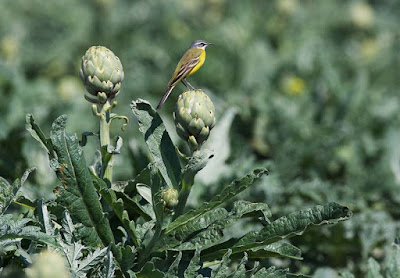 |
| One of the three Dupont's Larks we saw from our car. |
Erik Hirschfeld, renowned Swedish birder, author and publisher,
contacted us some time ago with one desire: to see the last European Bird
species he still had missed, the Dupont’s Lark (Chersophilus duponti). This scarce
and elusive lark species is present in Navarra (upper Ebro Valley) and still
helds a small population in the South of the region, so when Erik came in early
April this area was our destination to search for his desired bird.
On April the 10th and after having breakfast in the hotel we
drove to the steppes. Erik maybe thought that finding this bird could be
tricky, but as we know well the area once we arrived and put down the windows
of the car we inmediately heard the melodiuos song and saw a Dupont’s Lark
singing perched on a rock! After this one we heard at least ten other birds
singing and saw two more quite well. Mission acomplished! We spent more tan two
hours watching these birds running quickly, hunting insects and worms and
making a full perfomance of songs, including one long flight song which is very
rare.
We had plenty of time to visit other areas and search for
other steppe birds, so the day was completed with other species such as Greater
Short-toed Lark, Calandra Lark, Thekla Lark, close views of Pin-tailed
Sandgrouse, several Black-bellied Sandgrouse, Egyptian Vultures, Montagu’s
Harriers, Lesser Kestrels, Stone Curlews, Great Bittern, Southern Grey Shrikes,
Black Wheatears, Black-bellied Wheatears, Spectacled Warblers, Rock Sparrows among others.
 |
| Erik scanning the steppes for raptors. |
 |
| A male Black-eared Wheatear singing for us. |
 |
| Spectacled Warbler marking his territory from a bush. |
 |
| Combining birding and gastronomy... Why not? Iberian Yellow Wagtail perch on artichoke. |
El ornitólogo, autor y editor Erik Hirschfeld vino a Navarra
a comienzos de abril para cumplir un deseo: ver la última especie de ave
europea que le quedaba por ver: la alondra ricotí. Esta escasa y esquiva
especie mantiene algunas pequeñas poblaciones en el sur de nuestra Comunidad
Autónoma, por lo que era un lugar excelente para que Erik pudiera hacer
realidad su deseo. Y así fue, pues no solo oímos hasta 10 aves cantando, sino
que vimos tres bastante bien. Además las estepas navarras nos regalaron otras
muchas especies de interés tales como gangas ibéricas, gangas ortegas,
collalbas negras, currucas tomilleras, terreras comunes, alimoches, aguiluchos cenizos, alcaudones reales y muchas
otras.


